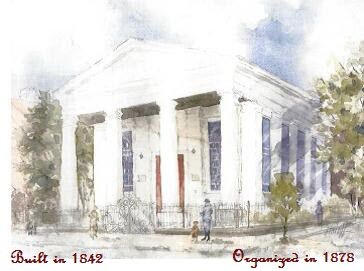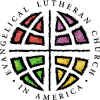The History of St. Johannes Lutheran Church
On October 11, 1841, officers of the German Evangelical Lutheran Church of Charleston contracted with John Dawson, a builder, for the erection of a Classical Tuscan Church Building on the northwest corner of Hasell and Anson Streets. The architect was the distinguished Edward Brickell White. The new sanctuary was completed on June 15 and dedicated on June 22, 1842. The cost was $11,000.
The fire of 1861 did not damage the building to any great extent. Only the windows and some furnishings suffered as a result of the bombardment during the Civil Was between the States.
In March 1872, the congregation now known as St. Matthew's Lutheran Church moved to a new edifice on King Street. The building which they formerly occupied was sold to Salem Baptist Church in 1872, and they occupied the property until 1878.
On April 11, 1878, a group of 53 Lutherans joined together and organized a congregation to be known as the "Deutschen Evangelisch-Lutherischen Sanct Johannes Kirche." For several months this congregation worshipped in what was then known as the Hasell Street Chapel near Meeting Street. A building committee was appointed to select a suitable site and plans for a church edifice for the newly formed congregation.
Shortly after that time, the former edifice of St. Matthew's became available and was purchased for $4500, with an additional $1313 spent for repairs and furnishings. On Sunday, October 13, 1878, their first service of worship was held at 48 Hasell Street. It was not until 1910 that the German language was discontinued in the worship and instruction of the congregation. The first congregational meeting was held on April 22, 1878, at which time a constitution was adopted, and the official Church Council was elected with 18 members. At this meeting a call was extended to the Reverend Johannes Heckel of Ohio to become the congregation's first pastor. Reports show that the congregation began to grow in numbers and activity. A Sunday School was organized in 1878 with 80 scholars and 16 teachers. There were two women's societies with 80 members. In 1880, the church was free of debt. By 1887, the membership had grown in communicant members to 250.
Minutes show that Miss Johanna M. Klenke tendered her resignation from playing the melodeon for the church music in April 1881. Through solicitations from the members, a pipe organ was installed in 1883 for $498. Miss Ernestine Metz served as the organist from July 1887 until March 1941, when Miss Louise Mathis was employed and served faithfully until June 1979. Since that time, three more organists have served, bringing a total of only six organists in the history of the congregation. Today, George Hiatt serves as organist-choirmaster. St. Johannes has always enjoyed the distinction of outstanding musical direction.
In 1891, a parsonage was purchased at 5 College Street for $3500. This remained the parsonage until 1919, when it was sold for $6000 and the money applied toward the purchase of 50 Hasell Street for a parsonage at a cost of $10,000.
Because of added membership, better Sunday School; facilities were needed. In May of 1890, a wooden structure was dedicated. The cost of the addition was $1,562.
In 1913, extensive repairs and improvements were made to the church edifice, including addition of an open and massive approach over the entrance with marble tile floor; open railings around the galleries; enlargement of the choir loft; removal of the circular chancel railing and remodeling of the chancel floor; and, installation of electric and gas fixtures in the interior and front entrance. Art Memorial Windows were installed by individuals in memory of loved ones at a cost of $5000. Total cost of the improvements was $10,940. Through pledges and legacies, the debt was paid within two years. In 1920, the original pipe organ was remodeled and rebuilt for $3276.
Again due to the need for space in educational facilities, a lot was purchased for $5500 on Anson Street for the future site of a modern parish building. Anticipating the commemoration of the congregation's "Golden Jubilee" in April of 1928, the erection of the building was begun in September 1927 and completed on March 1, 1928. Services commemorating St. Johannes' first half century of history began on April 15, 1928. The cost of the addition was approximately $30,000. At that time the Sunday School listed 250 scholars and 27 teachers and officers. The Reverend Dr. I.E. Long became pastor in March 1920, and continued in loving service until his retirement in September 1957, after having served this congregation 37 years. During his pastorate, the congregation grew in great numbers and in a primary position in the ministry of the Lutheran Church in Charleston.
In 1949, a new Austin pipe organ with cathedral chimes was installed. Following Dr. Long's retirement, the Reverend John Satterwhite was called to be pastor in 1958. A second parsonage was purchased at 217 St. Margaret Street; a new kitchen facility was added to the parish building; additional property was acquired at 46 Hasell Street; and, Art Glass Memorial Doors were added at the entrance of the nave in memory of Dr. Long, who died in 1958.
Due to the establishment of several mission churches in the area and changing living patterns in the city, St. Johannes began to decline in membership. In 1965, the Reverend George B. Sealy became pastor, and though his ministry was brief, the congregation responded to his devotion and leadership and carried forth the mission of the church with great influence in Charleston.
Discussion had begun between St. Andrew's Lutheran Church and St. Johannes about a possible merger of the two congregations. The proposal was defeated by vote of the congregation of St. Johannes. She asserted her continuing ministry in issuance of a call to the Reverend Gary L. Safrit to become her next pastor. Because of deterioration of properties, plans were formulated immediately for extensive renovation and restoration. The parsonage at 217 St. Margaret Street was sold and monies used to restore the antebellum 50 Hasell Street parsonage for $25,500. Pastor Safrit resigned in June 1972, and the Reverend Frank E. Lyerly became pastor in August of that year. Reverend Lyerly resigned in June of 1974, and the Reverend Clifford A. Riis served as pastor from 1974 until 1993. In 1995, the Reverend Dr. C. Lynn Bailey became pastor and served the congregation until September 2006.
The Centennial Year of St. Johannes celebration began on Easter Sunday, March 26, and continued through April of 1978. On April 30, 1978, the Centennial Church Service was conducted with participation by former Pastors Satterwhite, Shealy, and Safrit. The Reverend Dr. H.W. Cauble, President of the S.C. Synod also participated in the service.
In the fall of 1996, the rear portion of the parish building was restored and refurbished to be used as a chapel for Taizé Common Prayer services. In October 1997, a previously unused outdoor area behind the Taizé Chapel was converted to a memorial and prayer garden known as the Garden of Beatitudes. In creating this garden, an existing wall separating St. Johannes from the adjoining property of St. Andrew's Lutheran Church was removed allowing access to the garden by members of both congregations, as well as visitors. In October 2000, the beauty of the sanctuary was enhanced by members of the Society of Gilders participating in a community project through the addition of 22K gold gilding to portions of the lectern, altar, and pulpit.
In 2000, consideration was once again given to a possible merger of the congregations of St. Johannes and St. Andrew's Lutheran Churches, and again, a decision was made for the congregations to remain autonomous.
Dr. A.G.D. Wiles has said, "Outstanding are the simplicity of design, the warm and genuine interior, its rare beauty in stained glass and other appointments; it is an architectural gem in the heart of historic Ansonborough."
Today, St. Johannes sits in the heart of historic downtown Charleston, and yet remains a vibrant and active congregation. The Mission Statement of St. Johannes, developed in 2001, states: "St. Johannes Lutheran Church, located in the historic Ansonborough district of downtown Charleston, South Carolina, is a Family of Faith. We strive to provide sacred worship, space for silence, service to the community, commitment to tolerance and inclusive love, that all people who come here may discover the Heart of God in the Heart of the City."


